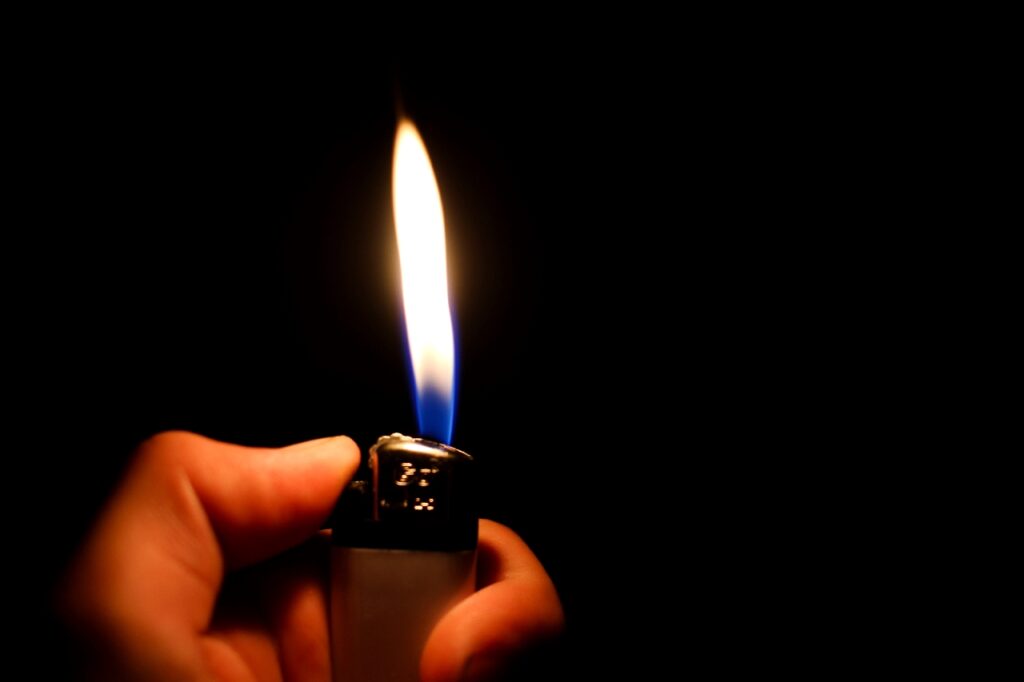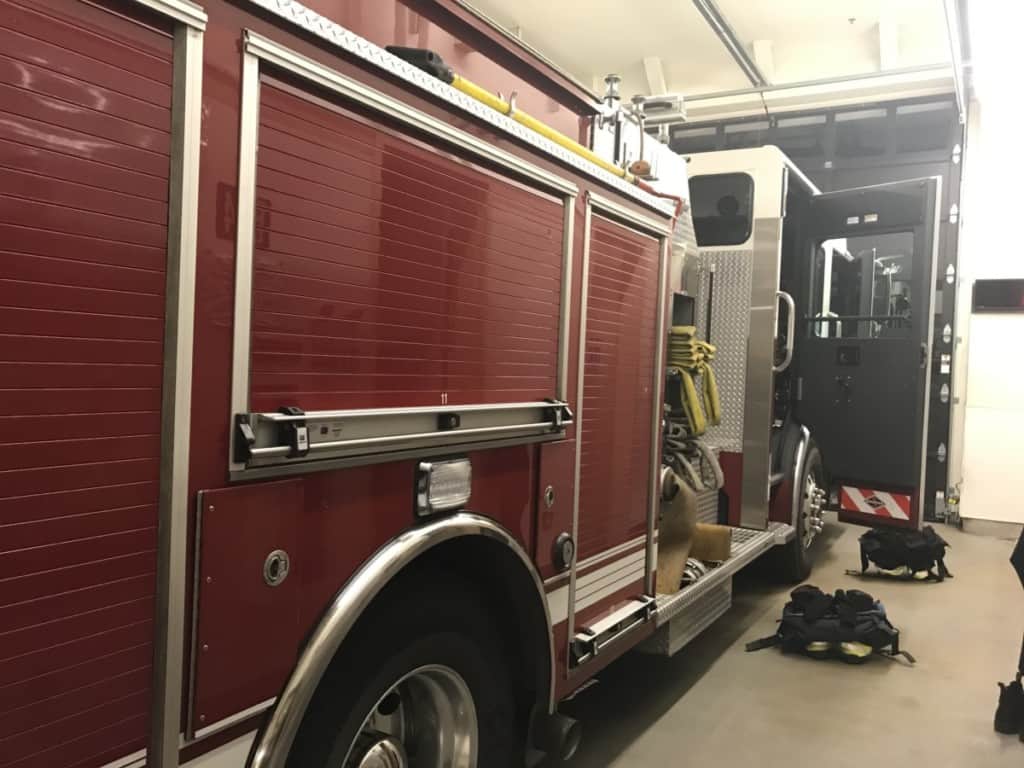Lighters, thankfully, are becoming less common in society now as more and more people quit smoking but they still have their uses for starting fires or lighting candles. How hot do these lighter flames actually get?
The common disposable lighter tends to be filled with butane (which can burn at 4,074 degrees Fahrenheit) or naphthalene (4,591 degrees Fahrenheit) but there are other types of lighters that burn at different temperatures and the absolute heat of a lighter can be influenced by air movement and the ambient temperature too.
So, let’s take a look at the different types of lighter and how hot they burn and a few safety tips to prevent you from getting burned too.
Your # 1 priority is keeping your family safe. As a firefighter, I recommend everyone has updated smoke detectors that don’t require battery changes, like these ones from Kidde, a fire extinguisher, like this one from Amerex, and a fire escape ladder if you have bedrooms above the first floor, I recommend this one from Hausse.
Also read: What Is The Temperature Of Fire? How Hot Does it Get?
What Temperature Do Lighters Burn At?

The butane lighter is, by far, the most common form of disposable lighter as it is a good fuel for lighters due to its low ignition point of around 77 degrees Fahrenheit.
Thus, it ignites in the presence of a spark (such as the one created by the lighter’s user when they turn the grinding wheel of the lighter over the flint) very easily. There’s no need to create a “pilot light” for the butane to burn over.
The theoretical maximum temperature of burning butane is 4,074 degrees Fahrenheit but theory is all well and good, in the real world, you’re more likely to find butane burning at about 3,500-3,600 degrees.
The exact temperature will vary depending on how much air movement there is (windy days are not good for lighter flame temperatures), the local air pressure, and your own position relative to the airflow.
The flame also constantly loses some of its energy to the surrounding air which is what keeps the temperature down, so if you were stood at the North Pole, you could expect your lighter flame to be somewhat cooler than the same lighter flame at the equator.
The other common fuel for disposable lighters is naphthalene and this burns at a potential 4,591 degrees Fahrenheit but as with butane, you’d expect the actual temperature to be much lower as the flame will be affected by all the same environmental factors.
You can see a lighter flame temperature being measured here:
Also read: Is Butane Flammable?
How Hot Is A Plasma Lighter?
There is also a more modern option when it comes to lighters, the plasma lighter. These lighters work by creating a “plasma arc” from an electric current.
This creates a flame that is more than hot enough to light a cigarette or a candle or to start some kindling but it’s not as hot as the flame in a butane or naphthalene lighter.
A plasma lighter will create a flame that is a maximum of 1,100 degrees Fahrenheit.
There are some good reasons to switch to a plasma lighter if you haven’t already done so.
Not only does the plasma arc look quite impressive when you use the lighter (some of them even provide a “roaring sound” to make them feel even more substantive but there’s no gas inside the lighter to leak out.
This is a common problem with butane lighters, if the release valve gets depressed in your pocket, you can find that your butane lighter empties out very quickly, indeed.
And this lack of vapor also means that there’s no odor released when using a plasma lighter.
They are also kinder to the environment (recharging beats refilling), fully windproof, can be lit in every direction even upside down, they can’t be started in your pocket thanks to inbuilt safety features and over a long period of time, they work out more cost-efficient too.
If you’re stuck in the wilderness and need to depend on a lighter to survive, a fully-charged plasma lighter is going to be a much better bet.
To learn more about plasma lighters, watch this video:
How Hot Is The Fire From A Lighter? (How Hot Do Lighters Burn?)
It is impossible to give an exact temperature on the flame of any given lighter without measuring it, we’ve already seen that for gas-powered lighters there’s a substantial difference between the highest potential temperature and the actual temperatures in practice.
With plasma lighters, the arc is always about the same temperature, 1,100 degrees, due to the physical process which drives the arc.
Can You Touch A Plasma Lighter?
We need to stress at this point, before we answer the question in more detail, that while you “can” touch the plasma arc from a plasma lighter, it’s not something that we’d recommend that you do.
If you are determined to find out for yourself, however, you should be aware that a finger placed in the arc will give you an electric shock.
This is something similar to the kind of static shock that you can get from touching someone, but on an order of magnitude stronger.
You’re really going to know that you’ve touched a plasma arc because it will hurt and it could cause other issues.
This is not the same shock as taser a taser shock, but it’s certainly unpleasant enough that most people prefer not to do it twice.
What’s The Hottest Part Of A Lighter Flame?
The hottest part of a lighter flame depends on the color of the flame, and this will change depending on environmental conditions.
A blue flame indicates the part of the flame where the burning reaction is taking place in the most efficient manner, it means that the gas is being entirely consumed by being burned and that there is no waste.
As you might expect, this leads to the highest temperatures in the flame too.
Also read: What Is The Hottest Color Of Fire? How Hot is Blue Flame?
Is An Electric Lighter Safe?
Assuming that you use the lighter in a safe manner, then yes, an electric lighter is safe to use, in fact, it’s probably safer than a butane lighter and there’s very little risk that an electric lighter might explode.
(If you were to puncture a butane lighter or place it near a heat source, then a butane lighter might either spontaneously combust or explode as the butane expands within the plastic body of the lighter).
Most electric lighters are not designed to deliver a lengthy plasma arc and will terminate the flame within 5 seconds. They will, however, set fire to nearly everything that a butane lighter can set fire to if used in the appropriate manner.
Also read: Why Is My Candle Flame So High/Tall/Big/Small? Answered
Why Won’t A Gas Lighter Stay Lit For More Than 30 Seconds?
There are two problems with keeping a gas lighter burning for a long period of time:
- Your hand won’t like it – the flame of the lighter heats the head of the lighter including the bit that you’re holding down to release the gas and the metal wheel that you use to create the spark to ignite the gas. The longer you hold it down? The hotter that it gets. You’ll find that unless you want burns on your finger that you can’t hold it for too long.
- The lighter won’t like it either – a lot of cheap disposable lighters use cheap plastic components that would start to melt before you exhausted the fuel in a lighter, this would then seal off the gas and prevent it from burning.
However, if you were to decide that you really wanted to burn a lighter for all the butane in it, you’ll need a second lighter.
Take the first lighter, strip the top housing down so that all the remains are the nozzle for gas release and the release button. Then sellotape down the release.
Then use the second lighter to light the first, it will continue to burn until all the fuel is gone.
How To Make A Lighter Flame Bigger?
If your flame is inadequate due to local wind conditions, then you can turn your body to shield the lighter to increase the flame.
You may also find that your lighter has a little slidable control for the flame which allows you to release more fuel at a time.
Finally, you could make a lighter flame bigger by increasing the size of the outlet for the gas on the lighter itself (you can do this by pushing an unlit match – the back end – into the outlet nozzle).
Related Articles
How Hot Does Propane Burn? Answered
Is Fire Alive? Properties and Stages of Fire and Flames

